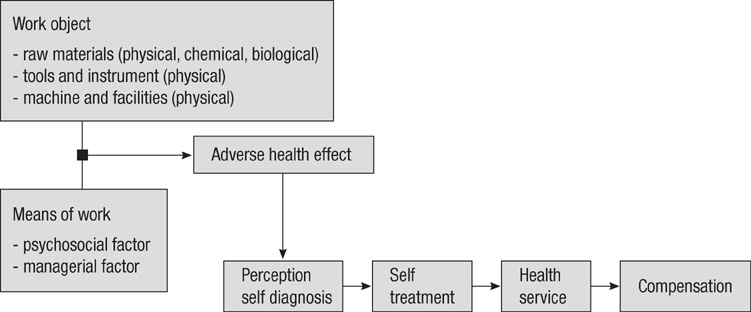J Korean Med Sci.
2010 Dec;25(Suppl):S119-S126. 10.3346/jkms.2010.25.S.S119.
Management System of Occupational Diseases in Korea: Statistics, Report and Monitoring System
- Affiliations
-
- 1Occupational Safety and Health Research Institute, Korea Occupational Safety and Health Agency, Incheon, Korea. rheeky@hanmail.net
- KMID: 1714077
- DOI: http://doi.org/10.3346/jkms.2010.25.S.S119
Abstract
- The management system of occupational diseases in Korea can be assessed from the perspective of a surveillance system. Workers' compensation insurance reports are used to produce official statistics on occupational diseases in Korea. National working conditions surveys are used to monitor the magnitude of work-related symptoms and signs in the labor force. A health examination program was introduced to detect occupational diseases through both selective and mass screening programs. The Working Environment Measurement Institution assesses workers' exposure to hazards in the workplace. Government regulates that the employer should do health examinations and working conditions measurement through contracted private agencies and following the Occupational Safety and Health Act. It is hoped that these institutions may be able to effectively detect and monitor occupational diseases and hazards in the workplace. In view of this, the occupational management system in Korea is well designed, except for the national survey system. In the future, national surveys for detection of hazards and ill-health outcomes in workers should be developed. The existing surveillance system for occupational disease can be improved by providing more refined information through statistical analysis of surveillance data.
Keyword
MeSH Terms
-
Accidents, Occupational/statistics & numerical data
*Environmental Monitoring/legislation & jurisprudence
Female
Humans
Male
*Occupational Diseases
Occupational Exposure
*Occupational Health/legislation & jurisprudence
*Occupational Health Services/legislation & jurisprudence
*Population Surveillance
Republic of Korea
Workplace
Figure
Reference
-
1. Ministry of Employment and Labor. Annual report of statistics on occupational injuries and diseases 2000-2009. 2001-2010. Ministry of Employment and Labor Korea Government.2. Occupational Safety and Health Research Institute. Korean working conditions survey 2006. 2007. Occupational Safety and Health Research Institute.3. Ministry of Employment and Labor. Annual report of the result of health examination 2000-2008. 2001-2009. Ministry of Employment and Labor Korea Government.4. Kang SK, Ahn YS, Kim KJ. Recent advances in occupational health research in Korea. Ind Health. 2004. 42:91–98.5. Markovitz SB. Rom WN, Markovitz SB, editors. The role of surveillance in occupational health. Environmental and occupational medicine. 1998. 3rd ed. Philadelphia: Lippincott-Raven;19–30.6. Cho SH, Hong YC, Leem JH, Chang SS, Chun BC. Occupational disease surveillance system: Planning and management. Korean J Occup Environ Med. 2001. 13:10–17.7. Leem JH, Chang SS, Kim SA, Moon JD, Chae CH, Hong YC, Kim SY, Kim JS, Kim YW, Han SH, Lee HS, Won JU, Song DB, Ha EH, Kang SK. Local occupational disease surveillance system in Korea: current status and issues. Korean J Occup Environ Med. 2001. 13:101–115.8. Kim H, Choi J, Rim H, Chang S, Lee K. Factors affecting the designation of cerebrovascular diseases as work-related in administrative litigation. J Korean Med Sci. 2008. 23:236–242.9. Halperin WE, Frazier TM. Surveillance for the effects of workplace exposure. Annu Rev Public Health. 1985. 6:419–432.10. Markowitz SB, Fischer E, Fahs MC, Shapiro J, Landrigan PJ. Occupational disease in New York State: a comprehensive examination. Am J Ind Med. 1989. 16:417–435.11. Castorina JS, Rosenstock L. Physician shortage in occupational and environmental medicine. Ann Intern Med. 1990. 113:983–986.12. Jennison EA, Parker JE. Rom WN, editor. The occupational and environmental history and examination. Environmental and occupational medicine. 1998. 3rd ed. Philadelphia: Lippincott-Raven;31–38.13. Matte TD, Fine L, Meinhardt TJ, Baker EL. Guidelines for medical screening in the workplace. Occup Med. 1990. 5:439–456.14. Rempel D. Medical surveillance in the workplace: overview. Occup Med. 1990. 5:435–438.
- Full Text Links
- Actions
-
Cited
- CITED
-
- Close
- Share
- Similar articles
-
- Overview of Occupational Health Management System in Korea
- Occupational Skin Diseases in Korea
- Contact dermatitis surveillance system in Taejon city: Prevalence of contact dermatitis among the workers exposed to solvents and nonmentallic chemicals through an immediate health examination system in Taejon city
- Trends of Study and Classification of Reference on Occupational Health Management in Korea after Liberation
- Occupational Disease Surveillance System: Planning and Management



